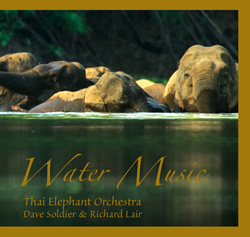In review--Another round for the elephants
Mulatta Records
(2000)
Dave Soldier & Richard Lair
Elephonic Rhapsodies
Mulatta Records (2003)
Water Music
Mulatta Records (2010)
Never in my wildest imagination did I ever expect to
review CDs by elephant musicians. True
elephants play music differently than humans, but when we consider that they
are limited to a trunk and their front feet, the music they do make seems
extraordinary. Little did I know ten
years ago, living in Seattle and testing recordings out on squirrels and crows
that musicians with a scientific bent in New York were actually playing music
with birds and elephants. While there
are likely animal advocates who will think that human musicians encroach upon
the non-human’s space for ego gratification, I would disagree. The musical interaction and interludes
between humans and animals or humans and birds reconnect humans to nature. It feels as if the animals are reminding us
to play more. Anyone who has ever watched crows frolic would understand the
need for all species to have fun.
Consider that the fourteen elephants who comprise the
Thai Elephant Orchestra (Water Music)
would be giving rides to tourists or lifting logs with their trunks to show off
their strength (tedious and boring), if they didn’t paint (yes, the elephants
paint) or play percussion instruments.
When you listen to the male elephant Jojo play his elephant xylophone on
the debut CD you can hear him trumpeting in excitement. When you watch the elephants in the
documentary (check out YouTube for the 5-part documentary on the Thai Elephant
Orchestra), the handlers known as mahouts can’t get the elephants to stop
hitting the gongs or playing the xylophones.
Elephants are intelligent, social, and playful creatures who fight back
when they feel exploited. We have
witnessed this with circus and zoo elephants, but clearly this is not the case
with the elephant musicians. The Thai
Elephant Conservation Center in Lampang, Thailand offers the elephants a
respite from arduous and abusive lives.
I also watched a video about a hospital for ill and injured elephants. Again, you witness an interaction between
humans and elephants, this time with the human musicians giving music therapy
to elephants.
In 1999, Richard Lair (an elephant conservationist in
Lampang) met with musician/science professor Dave Soldier in New York where the
idea to teach elephants how to play music was launched. First, instruments strong enough to withstand
monsoon weather and the strength of the elephants were built or purchased. Next, the mahouts and Soldier taught the
elephants how to play the instruments using their trunks. Finally, the crew and elephants produced
three recordings and a documentary portraying the process. The end results of the two recordings that
features the elephant orchestra (the 2nd CD has a mix of human-made music and
elephant music), sounds like musical sculptures played by elements (wind and
rain). Some of the pieces such as Thung Kwian Sunrise and Temple Music
that open the first CD sound like relaxing wind chimes. Harmonica
Music (elephants blow on the harmonicas with their trunks) sounds bluesy.
I listened to the 2010 recording Water Music over headphones so I could hear the nuances. I felt mesmerized by the music. Since I know that elephants performed these
songs, it’s hard for me not to feel some bias.
I wish that I had heard the songs before knowing the identity of the
musicians. If that was the case, I would
have thought that the music came from an indigenous culture untouched by
western civilization. The instrument
makers designed and constructed the instruments for Thai scales so that in
itself sounds exotic. The clanging of
gongs and the vibrations from the thunder sheet remind me of temple music and
others have also made that observation (as seen in the documentary and liner
notes).
Featuring 14 elephants ranging from age 3 to 29, the
songs sound lush with the elephants keeping good time, and weaving repetitive,
yet intricate patterns. It seems as if
the elephants listen carefully and play with intent. The
Last Monsoon of Summer features gentle percussion with relaxing
overtones. A sound healer could even use
this song to relax clients. The elephant
who plays the thunder sheet does seem enthusiastic, but the low vibration of
the thunder sheet has a relaxing quality, especially for people with a dominant
Vata dosha. Bathing in the River features a stunning percussion groove played
in an Asian mode. Whereas, Sun Breaks Clouds sounds slightly
discordant in an avant-garde manner, yet also feels festive with strains of
harmonica and bubbling xylophone. I’m
reminded of Jeffrey Thompson’s brainwave CDs.
The overall feeling is amazement, wonder and hope. I feel humbled by this music because never in
all my years of playing music did I ever play with innocence and total
abandonment in the manner of these elephants.
This is heart-chakra opening music at best.






Comments
Post a Comment